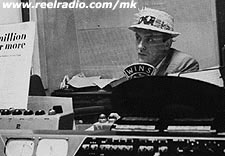Kaufman introduces the Beatles at the Wembley Stadium NME show, accompanied by the screams of thousands of young fans.
It was that popularity that led the Federal government’s Office of Economic Opportunity (OEO) to approach Murray about producing a national program that would a) appeal to inner city youngsters and b) let them know about job opportunities through the New Chance program. The show, It’s What’s Happenin’, Baby, which was arguably the first music video, attracted national headlines, the censure of Congressmen who deplored the use of public funds to broadcast “jungle music,” and too many inquiries from young people about a government program that turned out to be woefully underfunded.
Locally, Kaufman was innovative in other ways. He devised a new dance hall phenomenon that set the pattern for Manhattan’s Cheetah and San Francisco’s Fillmore Auditorium. In an abandoned airplane hangar at Long Island’s Roosevelt Field, the starting point of Lindbergh’s historic flight, he created Murray the K’s World, a multi-level, multi-media discotheque that combined live and recorded music with projected slides and film, providing a level of sensory overload that only Timothy Leary seemed able to exceed… with the help of mind-altering drugs.
As the World was taking off (and quickly crashing), WINS was changing formats. There was no more room for Murray the K and his cronies. Times were changing. The first threat was Top 40, a format which was considered before Group W’s decision to convert WINS to “all news all the time.” For someone like Murray, Top 40 was oxygen debt, cutting off the creative freedom to program his own show, choose his own music, take his own risks — like the time he refused to play the A side of Dionne Warwick’s new record because he was convinced that the B side would prove to be the hit. In spite of calls from everyone connected with Sceptre Records, Dionne’s label, Murray played the B side — Walk On By.
Within a year, Murray was leading a group of disillusioned talent to a new frontier — FM rock. On WOR-FM, Murray set the tone for the rest of the ’60s. He played records from albums, not singles, so that Bob Dylan’s Positively Fourth Street and Janis Ian’s Society’s Child were aired in full (one of the few places they could get played at all, initially).
At the same time, Kaufman was extending his OEO experience to produce local television specials that were combinations of on-location and in-concert performances punctuated by unexpected appearances by guests such as football great Joe Namath and the undisputed king of variety shows, Ed Sullivan.
Less than twelve months later, when Bill Drake came in to program WOR as an oldies-format station, Murray and the others quickly left. Not, however, before Murray told his listeners, as he had at WINS, just exactly what the executives were planning to do… before the executives had alerted the press. It won him few friends in a town where everyone in the industry knows everyone in the industry and where disloyalty is as ominous as a Mafia kiss.
Thanks to WINS’ nightly 50,000 watt clear channeling, Murray’s reputation reached far beyond the boundaries of metro New York. For awhile he aired in Toronto, then in Washington and Maryland before returning, in the early 1970s, to a national stint on NBC Monitor and, subsequently, to a regular program on WNBC.

